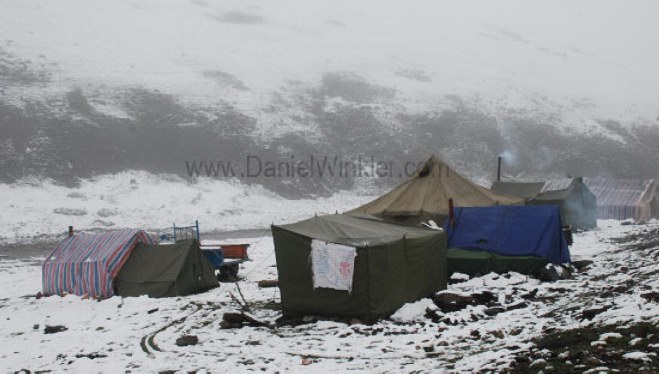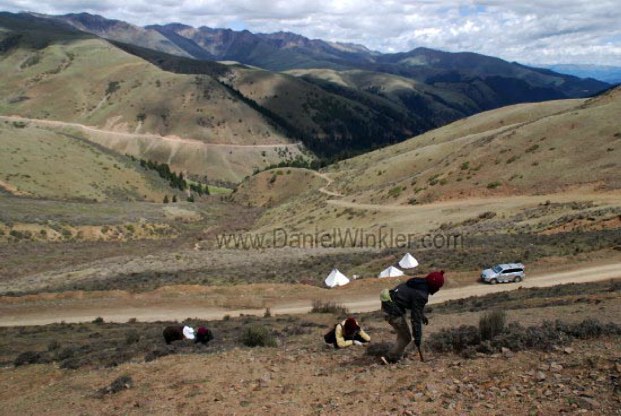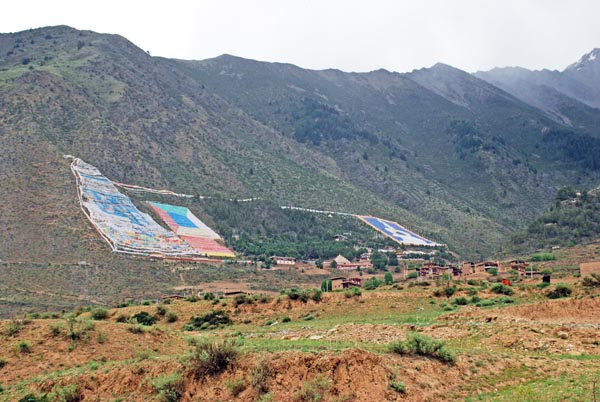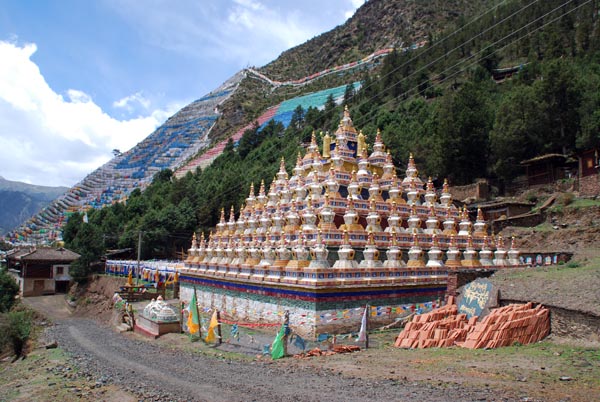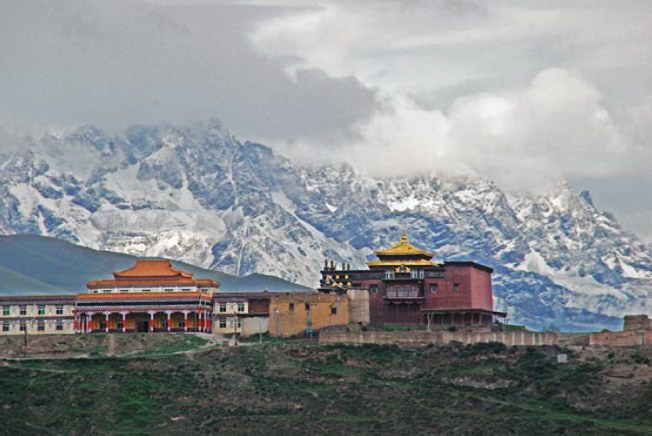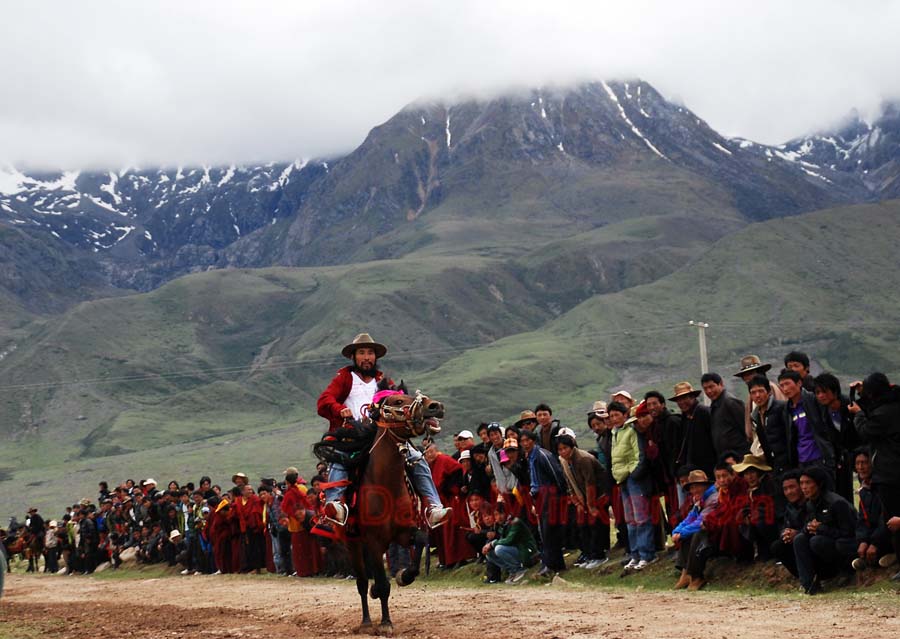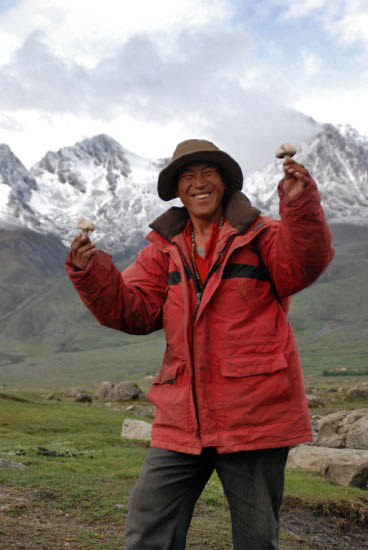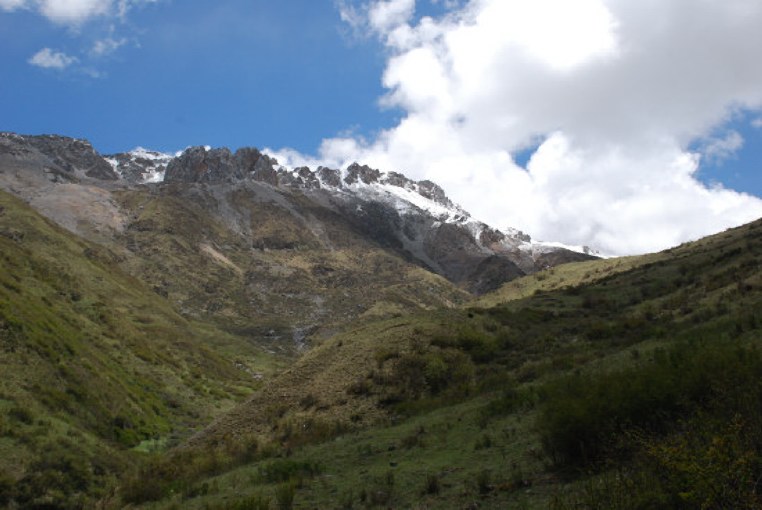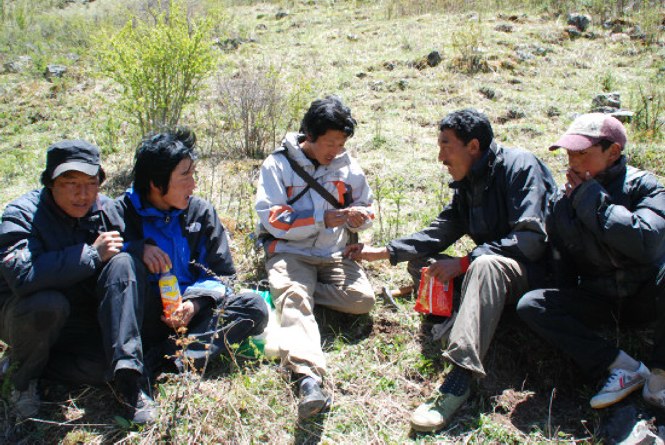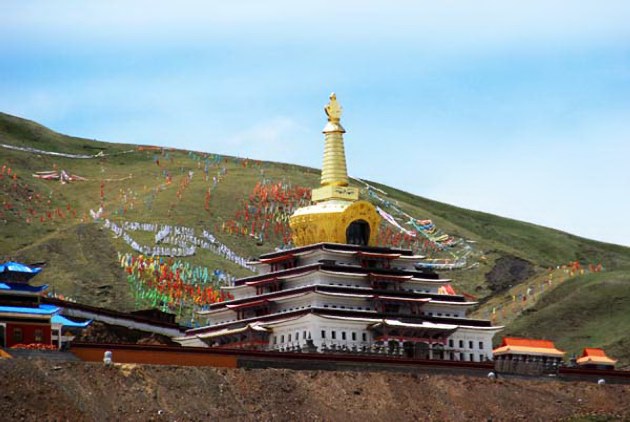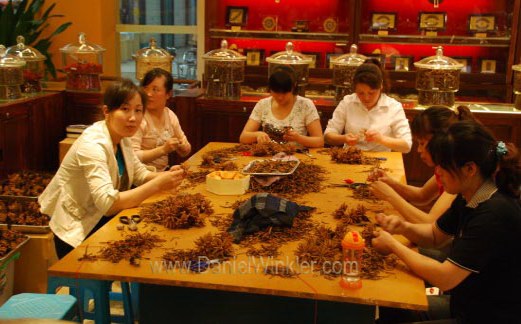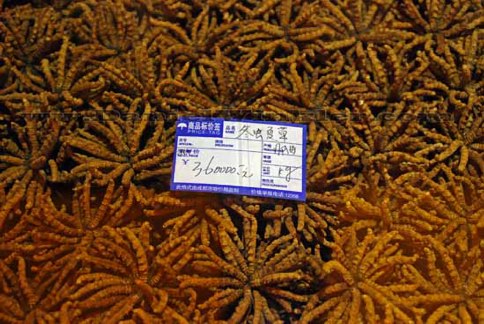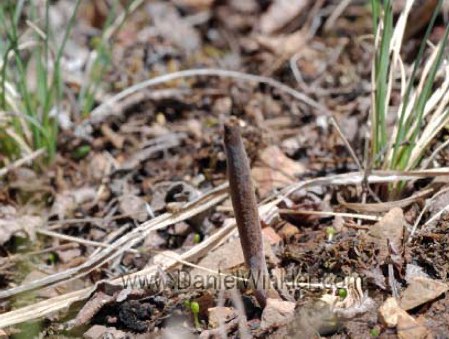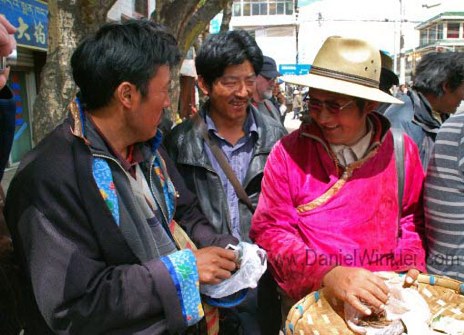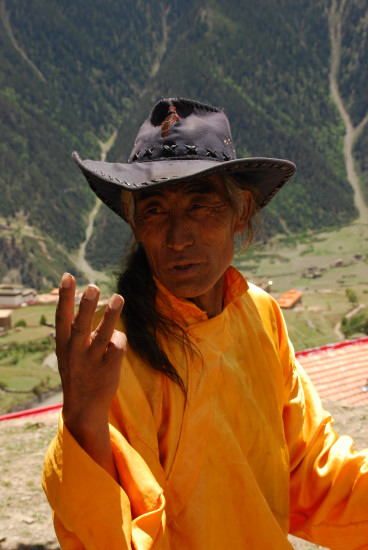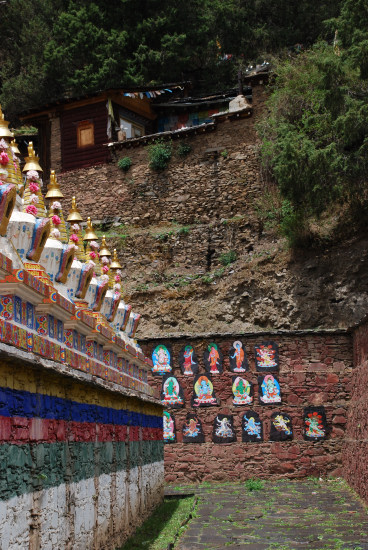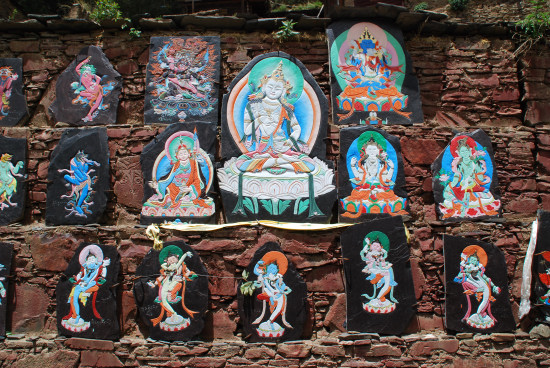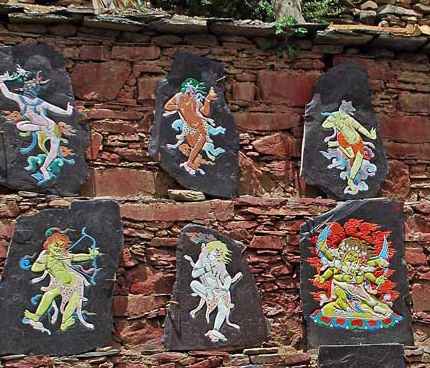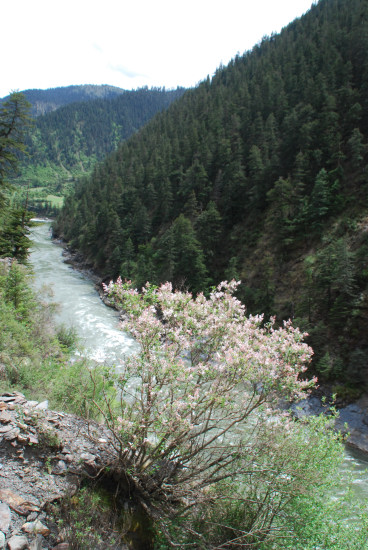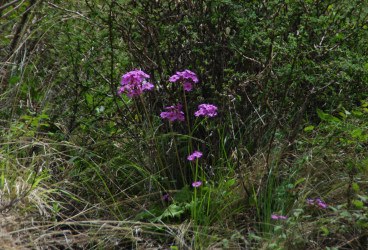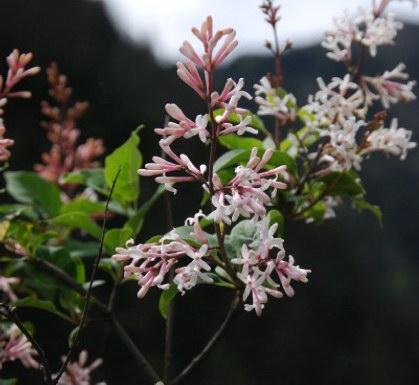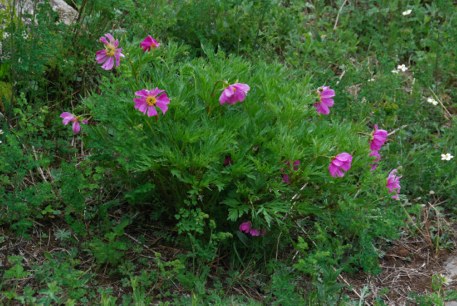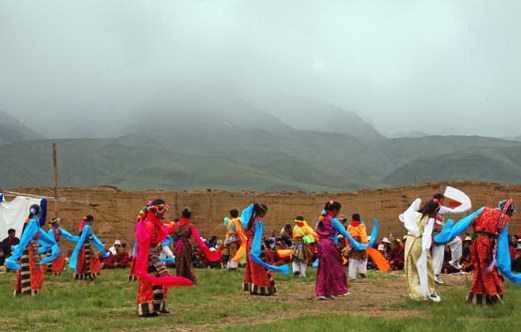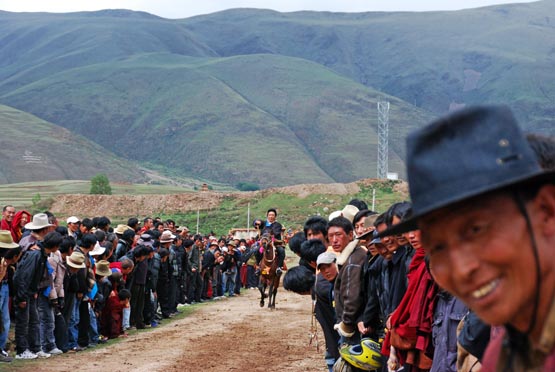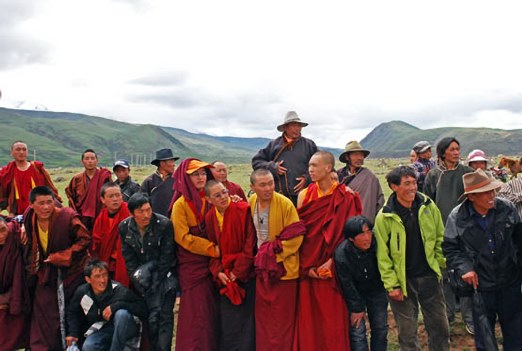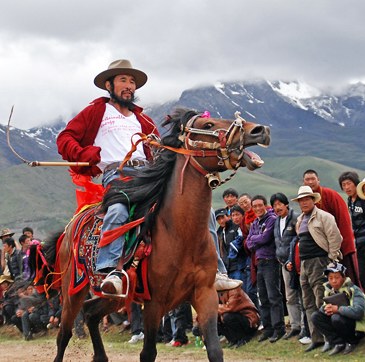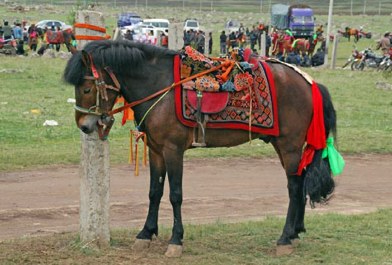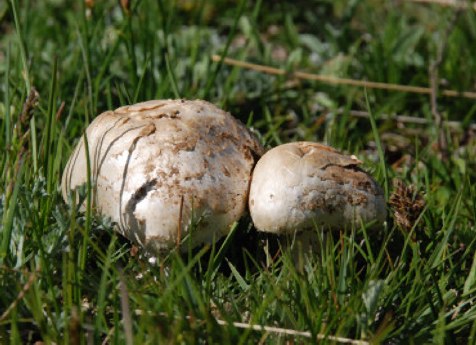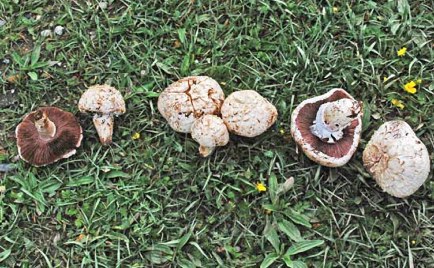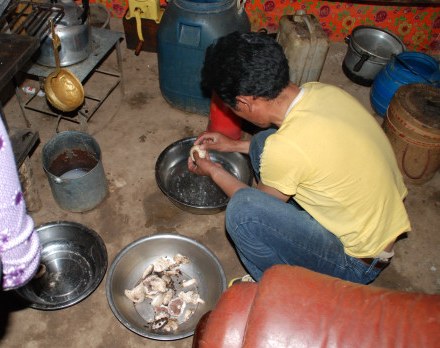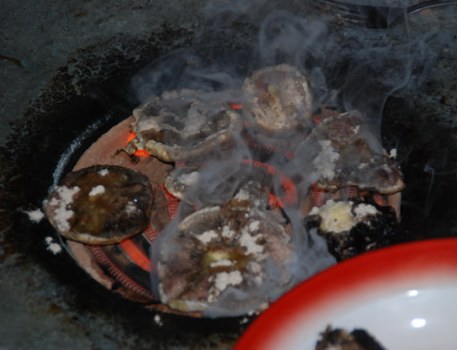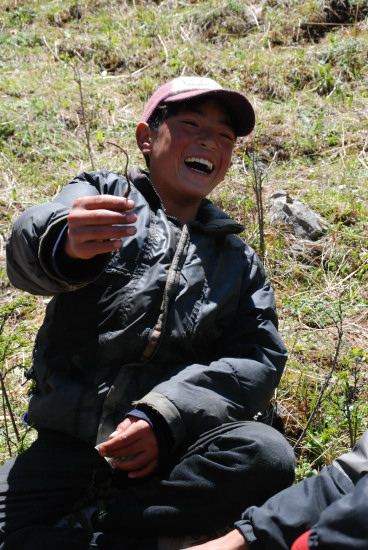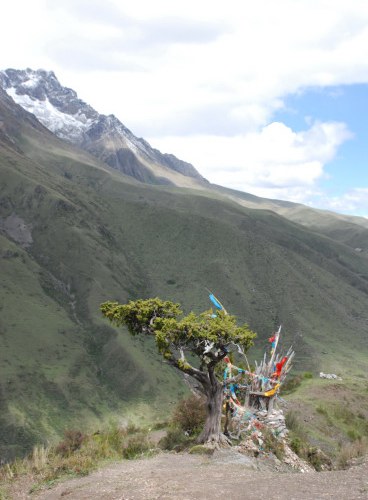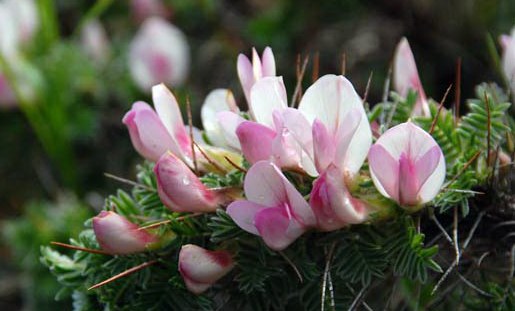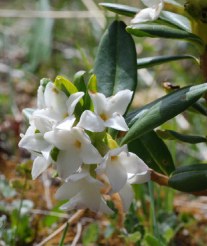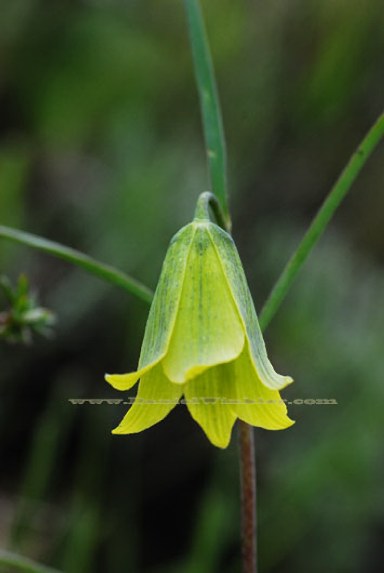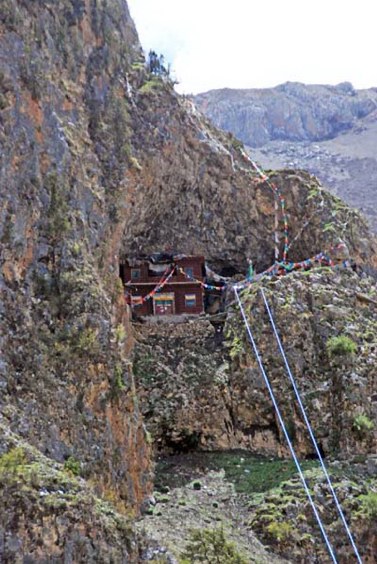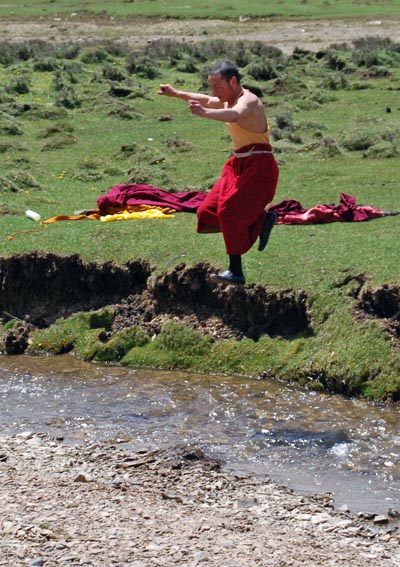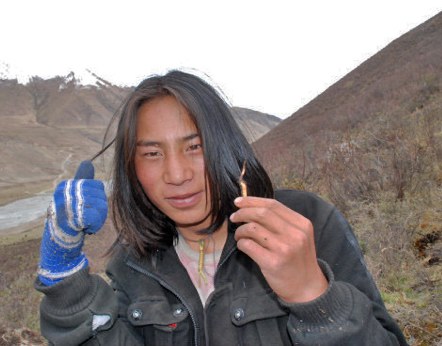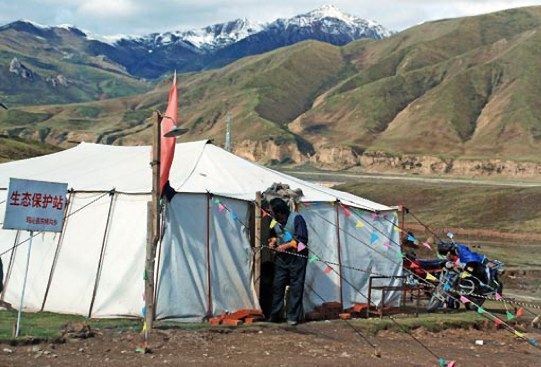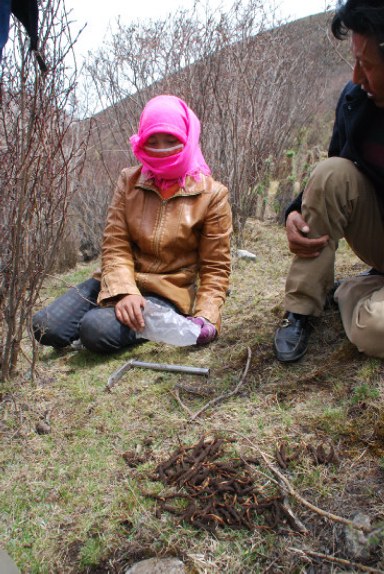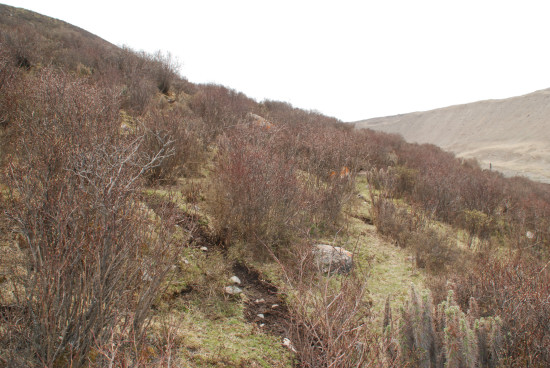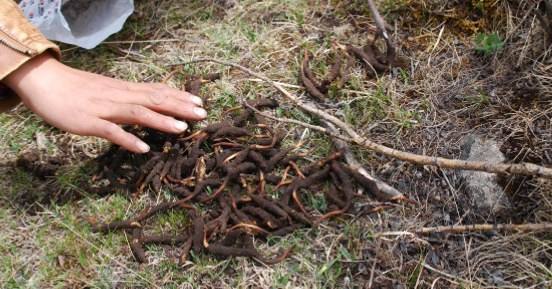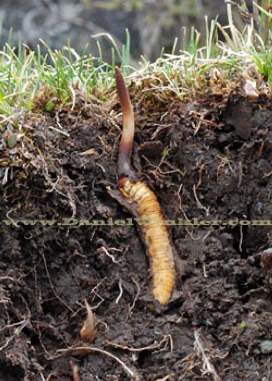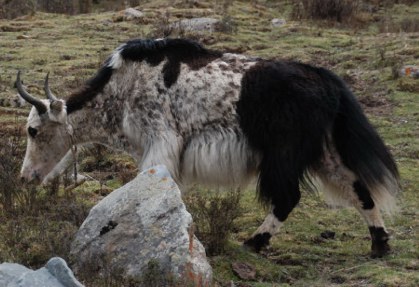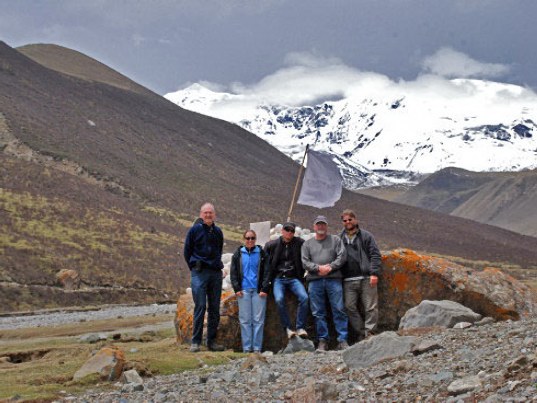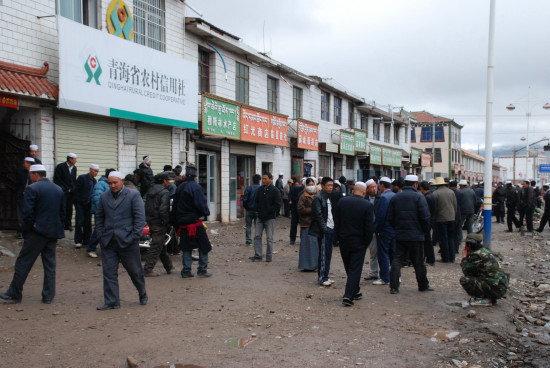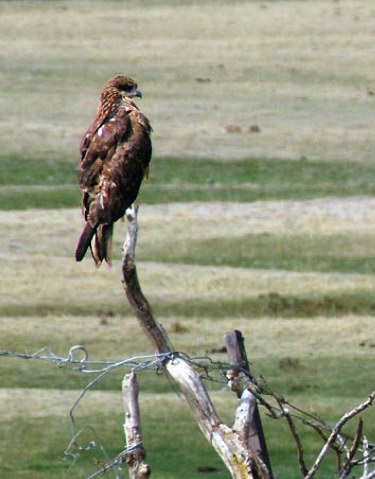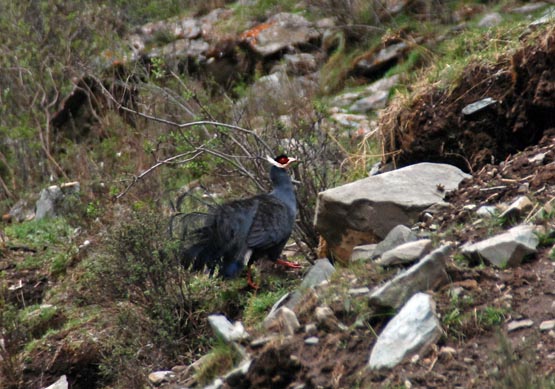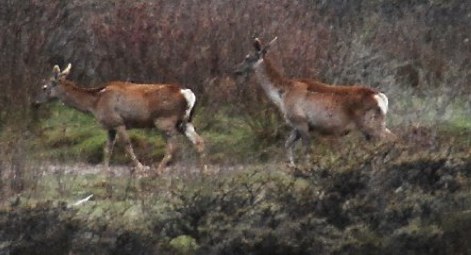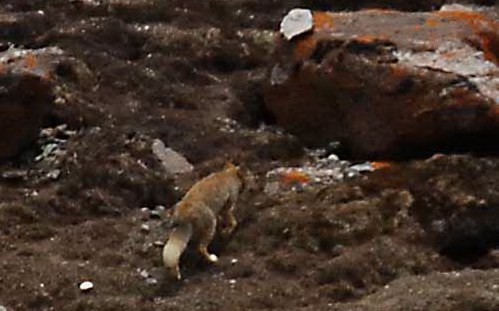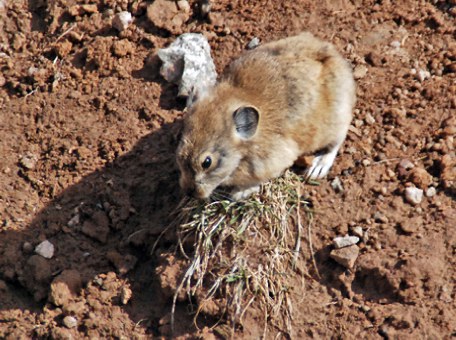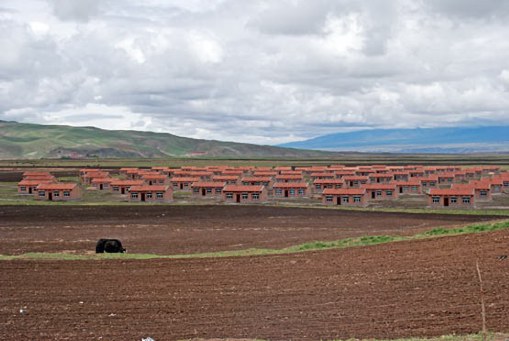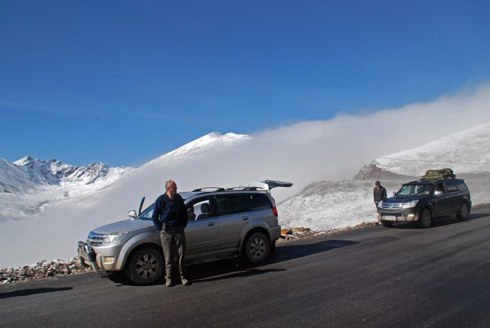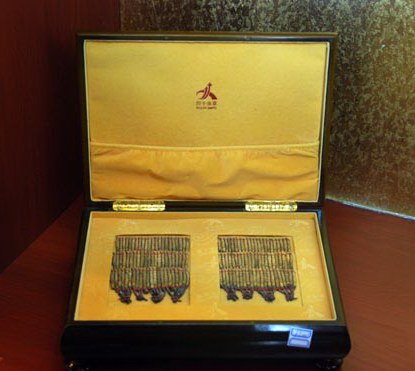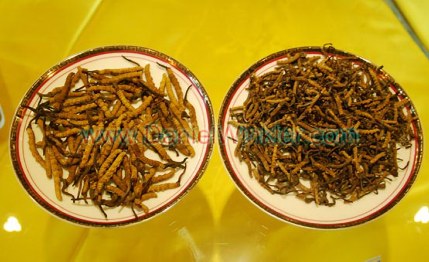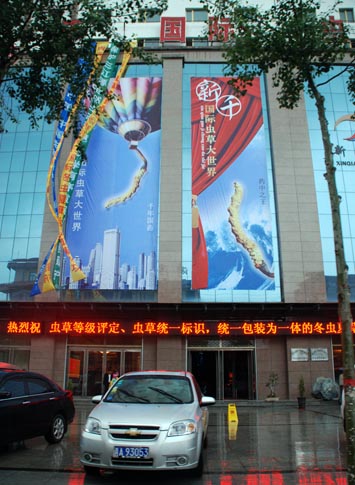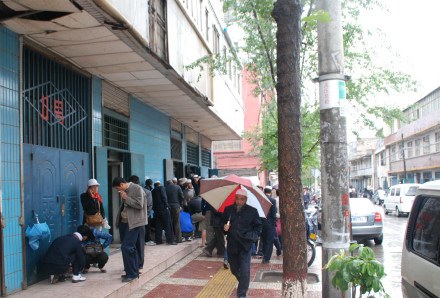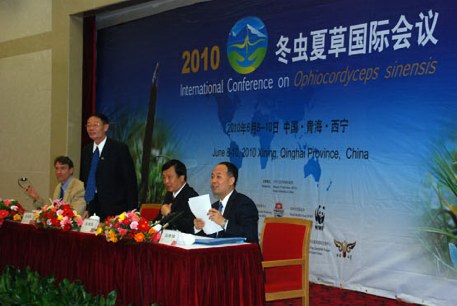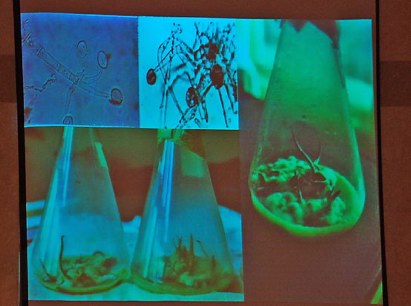Pictures from the 2010 MushRoaming Cordyceps Tour through Eastern Tibet (West Sichuan & Qinghai) We covered over 2500 km between Chengdu and Xining, crossing the Tibetan areas of Kham and Amdo. We hiked in lots of different Caterpillar fungus habitat, visited a range of cultural sites and enjoyed whatever interesting features nature had to offer.  Enjoy the photo tour! Enjoy the photo tour!  We started out in Chengdu visiting China's biggest medicinal herb, fungi & animal product market We started out in Chengdu visiting China's biggest medicinal herb, fungi & animal product market "Chongcao" being processed in a high end store in Chengdu. Prices here ranged from CNY 20,000 per kg for stromata only (none of the highly desired insect parts) up to CNY 360,000 per kg for the fattest, finest caterpillar fungi. | Here the fattest, finest caterpillar fungi for "only" CNY 360,000 per kg, which is over US$ 62,000. In Shanghai or Guangdong this quality might be even more expensive, crazy! | 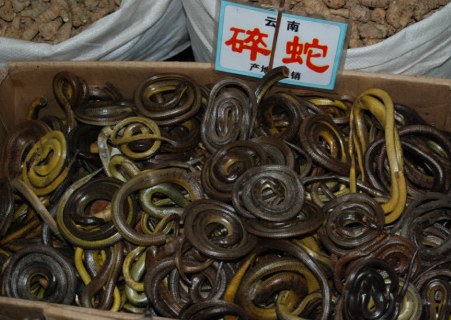 | 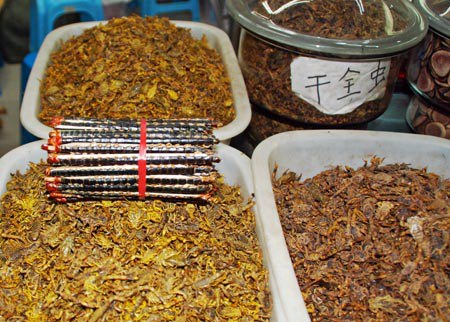 | Medicinal snakes, not just for decoration of Aesculap's staff and millipedes turned into a staff-like product for better bundling. Under the straightened millipedes piles up the mother load of scorpions to really make secure that healing experience gets traction. Medicinal mushrooms, even growing on caterpillars, are looking much better... |
Kham May 26 to June 2 Out in the field, the conditions were a bit more challenging, but luckily reoccurring snow and sleet did never impact our Yartsa gunbu hunt, but occurred only during traveling days. And it is not so bad sitting in a warm cushy SUV cruising thru a snowed in alpine landscape. Well, the cushiness gets often lost when the roads are really bumpy, but still better than hanging out in a tent waiting for the snow to melt. Not much is happening once it snowed. Collectors just hang out and have to kill time waiting until the snow melts. The day before the snow was already a day of rest since it was the 15th day in the Tibetan calendar, many collectors take off this holiday from collecting. 4400m, © Daniel Winkler, May 28, 2010, Nyachuka / Yajiang County, Kandze / Ganzi TAP, W-Sichuan Dorje, Thubten, Tashi Tsering and Drolma scanning the ground for bu. These guys are off course fully licensed collectors at CNY 600 per person, nearly USD100. Without license one is not allowed to collect Yartsa gunbu in Litang. As tourists we probably could not even buy a license and we are not there as competition interested in searching the mountains 12 hours a day for 5 weeks, although that might off- set the travel costs quite a bit :0} . So we just ask local bu hunters if we could accompany them and usually we are received warmly. If we find some buourselves we buy it from the locals. On normally they find nearly all the Yartsa gunbu anyway. Here we found only one, while they found ten.. We found our specimen in 4650m / 14,500 ft ! 2010 seems to be an excellent year for Ophiocordyceps sinensis on the Tibetan Plateau. | Close by grew this beautiful Iris, probably Iris ruthenica var. nana between Rhododendron nivalis. |
Himalayan Griffons (Gyps himalayensis) feeding on a yak carcass. We were awed watching the vultures walking and hopping up the slope. Their bellies were apparently too full to allow them a take off from the valley ground. So they walked up the slope, so they could gather some momentum for an easier take-off by first running downhill. 4200m, © Daniel Winkler, May 30, 2010, Litang County, Kandze / Ganzi TAP, W-Sichuan -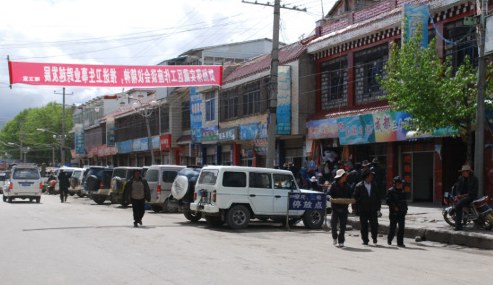 Litang's informal Bu market. Note all the Beijing jeeps and SUV's driven by the dealers. Very few of these were around the market when I saw it the first time in 1999. | Prices are higher in 2010 than in 2009. Maybe that is the reason that these Yartsa gunbu dealers are smiling in Litang. |
 The main temple of Litang Chode Gompa, founded originally founded by the 3rd Dalai Lama in 1580. The main temple of Litang Chode Gompa, founded originally founded by the 3rd Dalai Lama in 1580.
 Lhabung Gonpa under Mt Kawalori in Xinlong with a huge assortment of prayer flags hung. Lhabung Gonpa under Mt Kawalori in Xinlong with a huge assortment of prayer flags hung.A pilgrim in Lhabung | The Korwa (circambulation path) around the Lhabung stupa. |
 In Nyarong we saw several very colorful and ornate Stupas. The small Stupas build on the big one were all decorated with colorful tiles. In Nyarong we saw several very colorful and ornate Stupas. The small Stupas build on the big one were all decorated with colorful tiles.To me these tiles all seem like laminated color-copies, a technique that is not very long lasting when used as flooring. Nyarong County, Ganzi TAP, Sichuan Province.  A wall hung with over 100 beautifully carved and painted deities is behind the Lhabung stupa. A wall hung with over 100 beautifully carved and painted deities is behind the Lhabung stupa.This could be a depiction of the Hundred Peaceful and Wrathful deities from the Bardo Thodol, the "Tibetan book of the Dead" that appear to an initiated practioner in the process of death.
The native lilac is hanging on to a cliff high above the Nya Chu gorge in the North of Nyarong County. Primula polyneura grew right across the road. |
A fragrant wild lilac, probably Syringa sweginzowii, a.k.a. Syringa tomentella subsp. sweginzowii. 3400m © Daniel Winkler, May 31, 2010, Nyarong / Xinlong County, Kandze / Ganzi TAP, W-Sichuan Paeonia veitchii was in peak flower in many locations. Altitude: 3600m. © Daniel Winkler, May 31, 2010, Nyarong / Xinlong County, Kandze / Ganzi TAP, W-Sichuan |
 Rongpatsa, Kandze / Ganzi, June 1, 2010 Rongpatsa, Kandze / Ganzi, June 1, 2010Beru Gonpa between Kandze town and Rongpatsa. In the background the impressive Eastern extension of the Chola Ri Chain. Children's Festival with Horse Race  Tibetan horse races generate a lot of excitement in the audience. Spectators yell and howl when the riders comes by. Here it was not even a real race, but every rider paraded his horse and riding skills. Honestly, the riding style looks quite odd to me, since horses are not allowed to gallop full speed and the rider really pulls hard on the bridle to keep the horse in trot. Maybe it could be best described as a short-stepping, high-actioned trot. Tibetan horse races generate a lot of excitement in the audience. Spectators yell and howl when the riders comes by. Here it was not even a real race, but every rider paraded his horse and riding skills. Honestly, the riding style looks quite odd to me, since horses are not allowed to gallop full speed and the rider really pulls hard on the bridle to keep the horse in trot. Maybe it could be best described as a short-stepping, high-actioned trot.June 1st is all over China Children's holiday. Many festivals take place in or around schools. -
The kids performed beautiful traditional Tibetan dances. The dresses of the girls were beautiful, the materials they have are just incredible. The music was piped in full blast from CDs, unfortunately through a blasted loud speaker, but loud it was!
While some still look after the last rider, the next one comes racing down the narrow track. The excited crowd was driven back again and again by a fierce monk.
During the dances and singing the monks from nearby Rongpatsa Gonpa were by far not as excited as during the horse racing. Some monks were also riding. © Daniel Winkler, June 1, 2010, Rongpatsa, Kandze / Ganzi TAP, W-Sichuan | | This horse is moving full speed in a fast controlled trot (see below).
Some hoses were tied to posts and did not seem too comfortable out in the crowd. They were nervously moving in circles, pawing the ground and even chewing the concrete posts. |
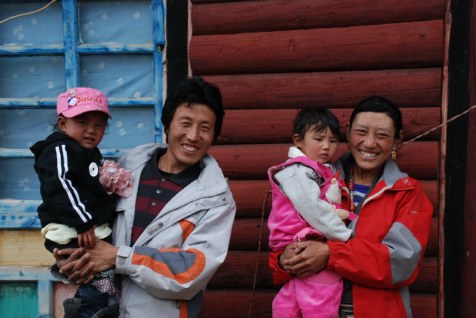 | 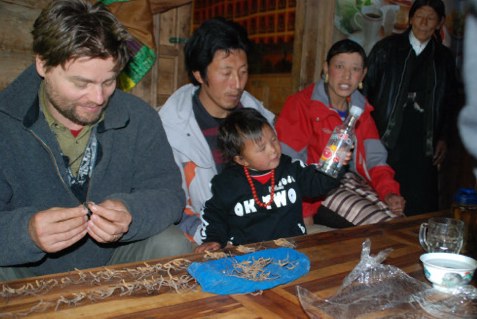 | Our guide Dorje - a really nice guy with great English - and his wife Jampa and their two cute daughters. | I am going through the Yartsa gunbu Jampa had collected in the 2010 season. I had promised I would buy all the bu she would collect. My first "major" bu deal, so far I focused on research on Bu and its past and present role in Tibet, besides its ecology, mycology and ethnomycology. |
 "Kar Sha" - Agaricus campestris - Meadow Mushroom "Kar Sha" - Agaricus campestris - Meadow MushroomLoga showing some Kar Sha in front of Rongpatsa's Sheda Mountains. I heard many stories about it and this time I had the chance to watch the preparation [see below]. 3400m, © Daniel Winkler, June 2, 2010, Kandze / Ganzi TAP, W-Sichuan Here Agaricus campestris is growing in grass in 3400m / 11500 ft. | Kar Sha or Karpo Shamo, the "White mushroom" in Tibetan denotes several Agaricusspecies. It is a favorite edible in Tibet nearly everyone knows, since it grows in pastures and around camps and villages in all altitudes, at least I have observed it between 3000m to 4800m (9'900 ft - 17'000ft). | Lobsang Ngodong washes the Karsha caps freed from stems from the outside without getting the gills wet. The stems are removed and set aside for another dish. | Lot's of steam develops while the caps - gills up - are being roasted.The increased water content from washing the outer cap proves very helpful frying them on the electric coil stove. Switching the coils off and on keeps the caps from being burned. | Lobsang Ngodong spreads tsampa, roasted ground barley flour, on top of the gills of the Kar Sha mushrooms. The butter, salt and tsampa cooks in the juice of the field Agaric. |
| Dechen offers some of the fried Karshas. They were very tasty! |
When Lobsang Senom and Topden, the kids of Dechen and Losang Ngodong saw how interested we were in mushrooms they dashed out of the house. Fifteen minutes later they came back with a bag full of Agaricus campestris and showed them to us. |
 Our driver Mr. Song Guoxiao took off on his own hike while we looked for Yartsa gunbu. He found a big patch of Lepista saeva = personata, the field blewit or blue foot in around 4300m. Some local Tibetans knew about its edibility, but it is by far not as known or common as Kar Sha, Agaricus campestris. © Daniel Winkler, June 2, 2010, Rongpatsa Kandze / Ganzi County & TAP, W-Sichuan |
|
Caterpillar Fungus Hunt Yartsa Gunbu, caterpillar fungus habitat we searched with success after hiking in for several hours. Mount Dinu, probably 16000ft in the background. © Daniel Winkler, June 2, 2010, Kandze / Ganzi County & TAP, W-Sichuan. Tenzin found a nice Yartsa gunbu. The season here is nearly over, all Ophiocordyceps sinensis are sporulating [see below] | A Lhatse, a pile of white quartz stones on a minor pass adorned with spear-like prayer flagpoles marked the entry to the Yartsa gunbu grounds. A last Shukpa - juniper attests to the presence of forests in the past. © Daniel Winkler, June 2, 2010, Kandze / Ganzi County & TAP, W-Sichuan |
Yartsa gunbu hunters showing Dorje, our guide their bounty. A late stage caterpillar fungus. Tibetans called it "tsar bu", overmature Yartsa gunbu. While the fungus is sporulating the underground larva becomes soft and will shrink heavily when drying and result in low value. © Daniel Winkler, June 2, 2010, Kandze / Ganzi County & TAP, W-Sichuan. |
Caragana jubata, belonging to the Leguminosae, has beautiful flowers and wicked, long thorns. Livestock seems not to bother trying to browse it (see left).
A fragrant Daphne |
|
| Fritillaria cirrhosa (Liliaceae) is one of Tibet's most important medicinal plants. Its pea-sized white bulbs are sold dried for export down to China. In Tibetan it is known as "Pema (Padma)" and in Chinese as "Chuan Beimu". All plants 4000-4200m © Daniel Winkler, June 2, 2010, Rongpatsa, Kandze / Ganzi County & TAP, W-Sichuan |
Perfect ending for a perfect MushRoaming day. Our guide Dorje relaxes in Rongpatsa's famous hot springs! What a view! © Daniel Winkler, June 2, 2010m, Kandze / Ganzi County & TAP, W-Sichuan On the (back) Road from Kandze via Sertar to Pema Sing Sing Dungkar monastery, one of Sertar's biggest monastery. The compound entails a nine-storied Milarepa tower, Zandok-Pelri Temple and a huge new stupa (see below). Besides these monuments there is a whole range of stupas draped in prayer flags. © Daniel Winkler, June 3, 2010, Sertar / Seda County, Kandze / Ganzi TAP, W-Sichuan A gigantic stupa-shaped building in Sing Sing Dungkar. © Daniel Winkler, June 3, 2010, Sertar / Seda County, Kandze / Ganzi TAP, W-Sichuan Retreat cave turned into house built into Tuku Mountain in Northern Kandze County (3820m) © Daniel Winkler, June 3, 2010 | Who says monks can't fly anymore? At least this Nyingma practioner is momentarily overcoming gravity crossing successfully a rivulet. © Daniel Winkler, June 3, 2010, Sertar / Seda County, Kandze / Ganzi TAP, W-Sichuan |
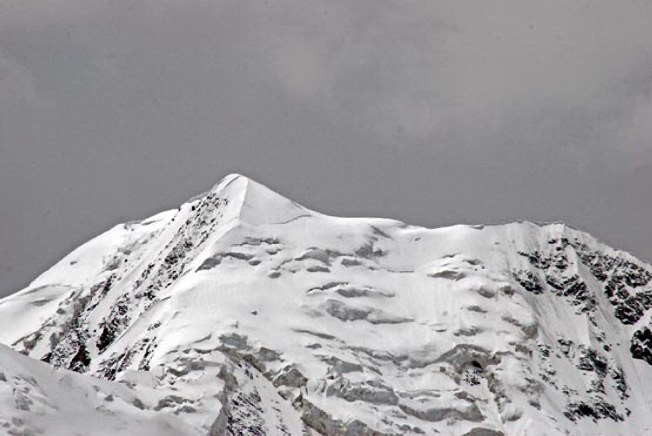
The main peak of Amnye Machen (6282m, 20610 ft) seen from its northern side is Amdo's most sacred mountain.
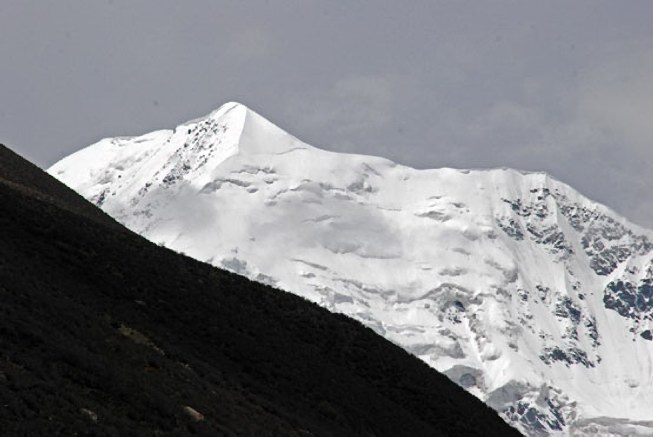
Amnye Machen is one of Tibet's four holiest mountains with Kailash / Kang Rinpoche, Kawakarpo (Meili Shan) and Minyak Gonkar (Gongga Shan).
Dorje with a Yartsa gunbu I found on the foot of Amnye Machen. | A check point tent along the highway on the North side of Amnye Machen. Locals are manning these checkpoints to keep outsiders from poaching their caterpillar resources. | Shirkye (16 years) and her family is blessed with some very productive habitat. She reported that she is finding around 100 to 120 bu per day, her little brother Losang only 10-20 a day. Overall she said she earns in one season around ¥50,000 from yartsa gunbu, more than ten times the annual average income! Just crazy! Most herders have houses now and drive "caterpillar cars", cars bought with caterpillar fungus money. | Open shrublands with willow (Salix sp.), Potentilla fruticosa & Caragana jubata.
Here Shirkye's booty in the early afternoon gathering above her home on their fenced in plot. | Here a beautiful specimen of Nga bu, early caterpillar fungus, when the fruiting body is still growing and the spore producing tissue is nor developed. Traditionally this is the most powerful state for medicinal use, but that has so far not been scientifically be investigated.
It was not clear if this yak was also searching for Caterpillar fungus.
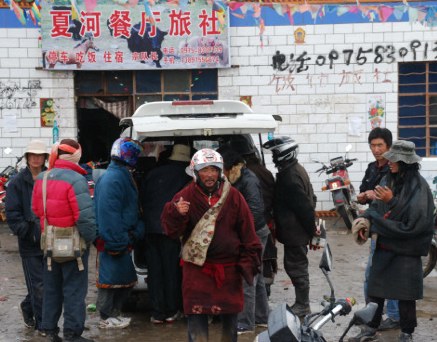
Dealing Bu in the rain in another roadside stop. The motor cycle repair shop doubled as a caterpillar fungus buying station. Maybe the collectors just hand in their bu and some day walk out with a new motorcycle? | A collectors camp in 4400m / 14'500 ft. The 2010 Cordyceps MushRoamers in front of Amnye Machen.
One of the outdoors Bu markets in Machen, the Prefectural Town of Golog / Guoluo. Lots of Hui, Chinese Muslim buyers are here, recognizable by the wearing caps. |
 Probably an Upland Buzzard (Buteo hemilasius) scanning the place for pikas (see below).  A Blue White-eared Pheasant (Crossoptilon auritum) on a alert. This pheasant is the most common of all the pheasant's in Eastern Tibet. Best chances to observe are in the winter when they come down to pick grain from the harvested fields. Also some monasteries feed them and one can see a flock of 20 or 40 of them. A Blue White-eared Pheasant (Crossoptilon auritum) on a alert. This pheasant is the most common of all the pheasant's in Eastern Tibet. Best chances to observe are in the winter when they come down to pick grain from the harvested fields. Also some monasteries feed them and one can see a flock of 20 or 40 of them.© Daniel Winkler June 6, 2010 Halong near Amnye Machen, Machen / Maqen County, Golok / Guoluo TAP, Qinghai Province. Deer crossing a river valley. We saw about 20 of them to the North of Amnye Machen. I would guess it is Mc Neil's Red Dear (Cervus elaphus mcneilii), but I am not 100% sure. | MushRoaming Wildlife - Machen June 2010 A wolf (Canis lupus) hunting Abra, Pika, (Ochotona spp.) just south of the divide between the catchments area of the Yellow River and the Yangtze in Pema / Baima County, Golok TAP, Qinghai. So far I only encountered single wolves in very remote areas with lots of Pikas. © Daniel Winkler June 4, 2010 A fox (Vulpes sp.) also hunting Abra (Pika, Ochotona spp.). Spotting foxes is fairly common, at least more common than encountering a wolves. © Daniel Winkler June 6, 2010 Halong near Amnye Machen, Machen / Maqen County, Golok / Guoluo TAP, Qinghai Province. A Pika (Ochotona sp.) feeding on grass. While Pikas feed on grasses and herbs, all big predators including bears, snow leopards, wolves and foxes and many of the birds of prey rely on the Pikas for sustenance. Thus, rather involuntarily, the Pika is a keystone species on the grasslands of the Tibetan Plateau. Repeated attempts by government agencies to control it by poising usually hits predator populations much worse, cause they come back much slower than fertile little Pikas with their litters of tens every 4 weeks or so. | Rabgye town along the Yellow River, known in Tibet as Ma Chu. Note the forest remnants on the slope above the river.
| A road side stop to enjoy the lifting clouds on a 4400 m / 14500 ft pass South of Machen. | We came across a whole bunch of these newly constructed settlements along our tour like here in Kawasumdo / Tongde County (left) and above Gomayin. These seem to be government programs to settle nomads. How much these programs makes is not clear. Most herders know how to herd and do not have many other qualifications that would allow them to make a living in suburbia. Of course there is caterpillar fungus digging, but 4 to 6 weeks of that alone does not really provide work year round. Furthermore, the policy is driven by the idea to reduce livestock pressure to fight overgrazing. However, many of these newly settled herders, just leave their animals with the extended family that has not left the grasslands or sell their livestock. Thus settling these households does not necessarily reduce livestock on the grasslands.
Xining The capital of Qinghai Province and one of the biggest bu market places. | Pema Tsering, a yartsa gunbu dealer showing 2 kg of caterpillar fungus, he was selling for RMB160,000 (US$ 24'000). Crazy! Handing over such a nice box can really improve your business relations! Side by side some of the biggest and some of the smallest caterpillar fungus. When it comes to the price, size does matter. These size classes are nearly separated by factor 10! | "Xinqian International Cordyceps Big World" is the official English Name of this caterpillar fungus super mall. Note the caterpillar fungus posters. Less fancy is the street Chongcao market in Xining. The street market as most of the stores in Xining are in the hand of Hui, Chinese Muslims. | | | On June 9, 2010 the opening session of the two day International conference onOphiocordyceps sinensis took place. The International conference was hosted by the Chinese Ministry of Agriculture and co-sponsored by the Center of Grassland Monitoring and Management and WWF was held in Xining, Qinghai Province PRC. | Although the main focus of the conference was resource management, several participants talked about artificial cultivation of Cordyceps sinensis. This is a very interesting and confusing aspect of this fungus. So far 28 different species of fungi from 13 genera have been reported as the potential anamorph of OphioCordyceps sinensis. A quite puzzling number of fungi growing out of tissues and spores of one species or are we dealing with a species complex? Time will tell. | Here a link to my paper submitted on Cordyceps Production and Sustainability | Last change 7-5-2010 |
 |
